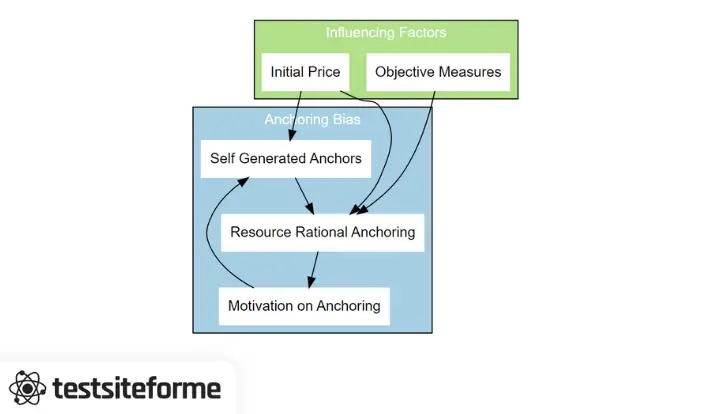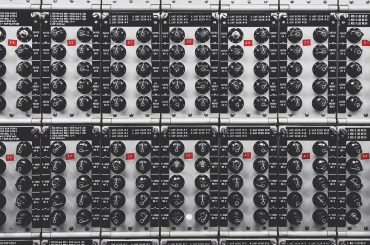The human mind is an incredible tool, yet it can be prone to a common cognitive bias known as anchoring. Like a ship mooring itself to the harbor floor, our initial impressions of a subject often become firmly embedded in our thinking, making it difficult to adjust and navigate away from them. But what is anchoring bias in research? Read on to learn more about this mental phenomenon and how researchers are using it to better understand decision-making processes.
Have you ever been stuck in a rut? Unable to think outside the box or make informed decisions without relying on your first impression? That’s exactly what happens with anchoring bias: we latch onto an initial data point — whether true or false — and use that figure as the primary basis for further judgments. This heuristic has implications far beyond everyday life; when used in scientific inquiry, anchoring bias can produce misleading results if left unchecked.
Though the concept of ‘anchors’ has been around since at least 1584, its application within psychology didn’t begin until 1974 when Amos Tversky and Daniel Kahneman proposed their groundbreaking theory on cognitive biases. In their study, they found that people tend to rely too heavily on information presented early on — regardless of relevancy or accuracy — skewing subsequent choices along predetermined lines. In other words, whatever we initially anchor ourselves against becomes our go-to source for judgment even though more accurate evidence may exist elsewhere.
Definition Of Anchoring Bias
Anchoring bias is a cognitive bias that occurs when people rely too heavily on an initial reference point (the “anchor”) to make decisions. This phenomenon is also known as the anchoring effect. It can be seen in many different situations, such as setting prices for products or judging one’s worth based on an anchor price set by someone else. People tend to use mental shortcuts and only consider information related to their anchor when making decisions.
For example, if you are looking at two cars and one car has been priced higher than the other, you may assume that the more expensive option is of better quality even though this might not necessarily be true. In essence, your decision-making process has been influenced by the anchor price set by the seller. Anchoring bias is common because it helps us make quick judgments, but it can lead to inaccurate assessments of situations if we don’t take into account all relevant factors.
Why It Happens
Anchoring bias is a cognitive bias that occurs when people rely too heavily on an initial anchor or piece of information to make decisions during the decision-making process. It has been studied extensively in social psychology and can have significant implications for how individuals interpret new data, draw conclusions, and act upon them. This type of bias often influences our perceptions based on the first pieces of information we receive – whether they are accurate or not.
To better understand why anchoring bias happens, it’s important to consider how humans tend to think about decision making. We usually pay more attention to the initial information we encounter rather than taking into account all factors related to a particular situation. In other words, this type of bias causes us to latch onto certain facts and ignore others that may be equally relevant. This then leads us to make decisions that don’t take into account all available evidence or feedback from experts.
We also know that anchoring bias can lead us down pathways of confirmation bias where we only seek out information which supports our original belief instead of looking at both sides objectively. This can cause people to become stuck in their ways without considering alternate points of view or solutions. As such, recognizing when you are relying too much on your initial anchor point is critical if one wants to remain open minded and come up with well rounded conclusions.
Types Of Cognitive Bias Involved
Anchoring bias is a type of cognitive bias that can have a significant impact on the research process. This bias occurs when someone relies too heavily on an initial piece of information, called an anchor, to make subsequent judgments. As a result, people tend to focus more attention and value on the anchoring point rather than considering all available evidence. Anchoring effects can be seen in numerous situations – from negotiation tactics to decision-making processes.
To avoid this type of bias, researchers must strive for objectivity by looking at data with fresh eyes and not relying solely on preconceptions or what they think might be true based on their previous experiences or beliefs. Additionally, it’s important to consider multiple pieces of information when making decisions related to research findings instead of just one single factor. By taking these steps, researchers can significantly reduce the likelihood of being influenced by anchoring bias during their studies and ensure the accuracy and reliability of their results.
Causes And Influencing Factors
Anchoring bias in research is a cognitive phenomenon that occurs when an individual’s decisions and estimates are based on the initial price of something, rather than objective measures. This type of bias has been studied extensively in both economics and psychology for many years and can have significant impacts on decision making processes.
The causes and influencing factors of anchoring bias include:
- Self Generated Anchors: These anchors are generated by individuals who use their own beliefs or values to determine what they consider the ‘right’ choice to be. People tend to rely heavily on these internalized anchors even if they know objectively that other options may be better suited to them.
- Resource Rational Anchoring: In contrast, resource rational anchoring involves using external sources of information (such as prices) as reference points, which can lead people to make decisions that are not necessarily optimal but still beneficial in terms of cost saving or efficiency.
- Motivation on Anchoring: Finally, motivation also plays a role in anchoring bias; people may be motivated to make certain choices because it makes them feel good about themselves or gives them a sense of control over their lives.
In short, anchoring bias has various causes and influences that need to be taken into consideration when conducting research or making decisions involving money matters. Keywords such as initial price, self generated anchors, resource rational anchoring, motivation on anchoring, and objective measures should all be considered when attempting to understand this important topic more fully.

Examples Of Anchor Bias
Anchoring bias is a cognitive phenomenon where people rely too heavily on an initial piece of information when making decisions. This anchor, or the initial reference point, can be either consciously or unconsciously used to make subsequent estimates. We may not even realize that we’re basing our decision on this first piece of information.
Examples of anchoring bias are seen in many aspects of life:
| Situation | Explanation |
|---|---|
| Mental Anchoring | Making decisions based on one’s own beliefs and feelings |
| Anchor Plausibility | Believing something simply because it seems plausible |
| Initial Estimates | Relying solely on the original estimate without considering other factors |
In some cases, people don’t fully understand the influence their reference points have on their judgement. In others, they might use these anchors as shortcuts for understanding complex issues quickly. Regardless, recognizing how anchors shape our opinions can help us become more aware and better informed about what we believe.
Effects On Experiments And Research Results
Anchoring bias in research can have a significant effect on experiments and their results. An anchoring bias occurs when people rely too heavily on the first piece of information they receive, or a ‘median estimate’, to make decisions. This is known as basic anchoring. It’s used by decision makers as a way to save cognitive resources, however, it often leads to inaccurate outcomes due to an overreliance on that initial median estimate.
Positive anchors are typically seen as more desirable than negative anchors, so researchers may be biased towards positive results. For example if they use an anchor of ‘positive’ then participants are likely to answer questions with answers that reflect this notion rather than responding neutrally or negatively. Similarly, if there is a negative anchor present then respondents will be more inclined towards giving negative responses instead of neutral ones. Anchoring has been linked to errors in judgment and incorrect data collection which can lead to unreliable conclusions about studies and experiments.
Implications For Data Analysis
Moving on, let’s analyze the implications of anchoring bias for data analysis. This phenomenon affects how people make decisions and judgments under uncertainty. Dual process theories suggest that cognitive processes are responsible for this effect, as it has been demonstrated in various experiments. For example, an anchoring bias example could occur when a researcher provides participants with incorrect information which is then used to influence their responses or conclusions.
In applied social psychology research, researchers need to be aware that anchoring bias may affect results; therefore, they should consider means of minimizing its effects during the design phase of the study. Strategies such as randomization can help reduce potential biases by ensuring that all participants are exposed to equivalent conditions without any prior exposure to additional information beyond what was included in the experiment itself.
Additionally, blinding techniques can also be utilized so that participants cannot infer the purpose of certain stimuli presented in the experiment. Taking these steps will ensure that data collected from experiments is more reliable and valid.
Ways To Identify Anchor Bias
Anchoring bias is a mental shortcut that occurs when initial information affects the decision-making process. It can be identified in research by looking for signs of confirmation bias, where evidence only supports one position or hypothesis. The easiest way to do this is through an elicitation method, which involves asking participants open questions and allowing them to provide their own answers without influence from researchers. This allows researchers to identify any potential biases they may have towards certain topics or ideas.
Another important factor when identifying anchoring bias is context; it’s important to consider all available evidence and not just focus on the first piece of data provided. In behavioral science, this means taking into account other factors like culture, language, values, and beliefs before making conclusions about people’s behavior. By doing so, we can ensure our findings are based on accurate and unbiased data rather than being influenced by any pre-existing assumptions or preconceptions.
How To Avoid It
Anchoring bias in research occurs when one’s initial response to a question or situation has an undue influence on the subsequent responses. To avoid anchoring bias, researchers should rely more heavily on empirical evidence instead of relying solely on their own subjective assessments. For example, if estimating the confidence interval of a distribution, researchers should normalise attribute values and compare them with actual values to determine accuracy rather than simply guessing at values.
In addition, researchers can refer to publications such as The Journal of Behavioral Decision Making for guidance on how to effectively use statistical techniques that reduce the risk of anchoring bias. Furthermore, it is important for researchers to be aware of any preconceived notions they may have about certain topics so that these do not unconsciously affect their decisions. By taking steps such as these, researchers will be better able to ensure unbiased results.
Effects On Human Behavior
Anchoring bias has been found to have significant effects on human behavior. This phenomenon occurs when individuals rely too heavily or exclusively on the first piece of information they receive, resulting in an inaccurate average estimate of situations and decisions. The error cost associated with this can be quite high; it is seen as a form of cognitive bias which influences people’s decisions and judgments, leading them astray from their normalised values for more subjective measures.
The following are some examples of how anchoring bias affects our everyday lives:
- When making financial investments, we may fixate on the initial price point rather than consider what other trends might influence its value over time.
- During job interviews, candidates often anchor themselves to one aspect of their skill set instead of showcasing all their abilities equally.
- We tend to remember only the most salient aspects about past events, creating a distorted recall measure that does not accurately reflect reality.
- In social settings, we sometimes let our first impressions dictate our opinion of someone without taking into account any additional evidence that may change our mind later on.
These are just some ways in which anchoring bias can lead us down incorrect paths due to illogical decision-making processes caused by relying too heavily on initial data points. It is important to recognise these biases in ourselves and others so that we can better make informed decisions in life.
Heuristics And Its Role In Anchoring Bias
Heuristics play an important role in anchoring bias. This type of cognitive bias is often seen when people make decisions, such as financial decisions that involve a lot of uncertainty.
Heuristics are mental shortcuts that help us quickly evaluate and make judgments based on limited information. According to a study published in the Journal of Personality and Social Psychology, people tend to anchor their decisions around a reference point or number even if it isn’t relevant to the decision they are making.
For example, an item may be priced at $100 but due to the influence of heuristics, another person might think it’s worth more than its actual value because they have anchored themselves to this initial price.
Furthermore, research from the Journal of Experimental Psychology found that once someone has been exposed to an unusually high figure for something (e.g., salary), then all future figures will seem relatively lower in comparison regardless of whether those numbers are reasonable or not.
Anchoring bias can lead individuals to overestimate or underestimate values which can result in poor decision-making in certain contexts. Therefore, it is important for people to be aware of how their thinking could potentially be influenced by heuristics when making decisions involving uncertainty such as financial ones.
Conclusion
In conclusion, anchoring bias is one of the most common cognitive biases in research. It occurs when researchers are influenced by initial information and tend to rely heavily on it while making decisions or forming opinions. This type of bias can be caused by various factors, including heuristics, which is a mental shortcut used in decision-making processes.
Identifying anchoring bias is important so that we don’t make decisions based on false assumptions. To do this, it’s essential to look for signs such as overreliance on early evidence, overly optimistic predictions and generalizations from limited data sets. Once identified, anchoring bias can be avoided by changing the way you think about data points and reframing questions to elicit more accurate responses.
Anchoring bias has serious implications for human behavior; it can lead to poor judgement and erroneous conclusions if not managed properly. By recognizing this issue, however, we can better understand our own thinking patterns and use them more effectively in research projects. With careful consideration and active attention to the potential sources of anchoring bias, researchers will become better equipped to form reliable conclusions with their studies.







